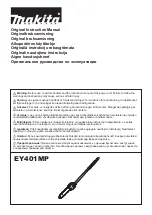
GB
- 366 -
•
Never cut into the bulging branch collar. This will prevent the tree
from healing.
Sawing o
ff
smaller branches (Fig. 26):
Place the contact surface of the saw onto the branch. This will pre-
vent the saw from making jerky movements when you begin a cut.
Exerting slight pressure, guide the saw from the top to the bottom
through the branch.
Sawing o
ff
larger and longer branches (Fig. 27):
Carry out a relief cut when working on larger branches.
Start by sawing through 1/3 of the branch diameter (a) from the bot-
tom to the top with the top side of the cutter rail. Then saw towards
the
fi
rst cut (b) from the top to the bottom with the bottom side of the
cutter rail.
Saw o
ff
longer branches in several steps to keep control over the im-
pact location.
Kick-back!
The term “kickback” describes what happens when the running
chainsaw suddenly kicks upward and backward. Usually, this is
caused by contact between the tip of the cutter rail and the workpiece
or the saw chain becoming trapped.
In the event of kickback, large forces occur suddenly and violently. As
a result, the chainsaw usually reacts uncontrollably. This can often re-
sult in very serious injuries to the worker or persons in the vicinity. The
risk of kickback is at its greatest when the saw is positioned for a cut
in the region of the tip of the cutter rail, as the leverage e
ff
ect is grea-
test there. It is therefore safest to position the saw as
fl
at as possible.
Important!
•
Make sure that the chain tension is always correctly adjusted.
•
Only use a chainsaw if it is in perfect working order.
•
Only work with a saw chain that has been properly sharpened in
Anl_PE_AHE_18_Li_Basic_SPK7.indb 366
Anl_PE_AHE_18_Li_Basic_SPK7.indb 366
15.01.16 13:09
15.01.16 13:09
















































